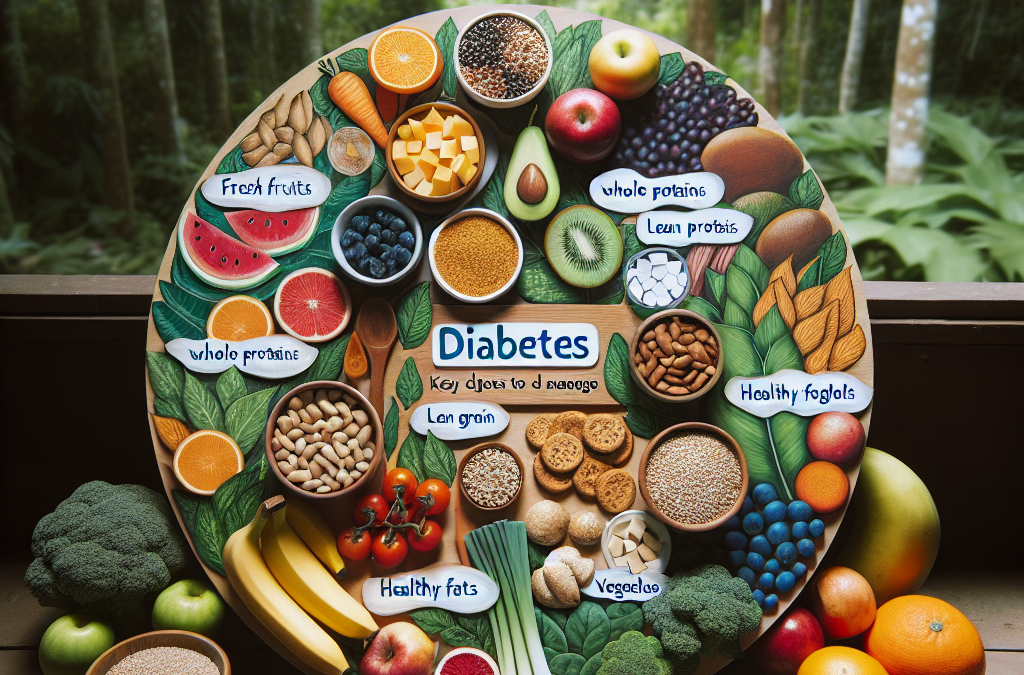Leafy Greens: The Powerhouse of Nutrition
Why Leafy Greens Are Essential
Let me tell you, leafy greens have become my best mates in managing diabetes! They’re low in calories and packed with vitamins and minerals. I threw out any notion that salads were boring when I discovered the vast array of greens available.
From kale to spinach, these leafy wonders support blood sugar control and are rich in antioxidants. I’ve noticed that incorporating greens into my meals keeps me feeling satisfied and energized. Seriously, what’s not to love?
And don’t forget about fiber! Leafy greens are a great source, helping to slow down the absorption of sugar in our bloodstream. If you’re not already eating enough greens, trust me, it’s time to change that!
Ways to Add Leafy Greens to Your Diet
You might be wondering, “How can I get more greens?” Well, I have some tips! First off, try adding spinach or kale to your smoothies. It’s an easy way to boost the nutrition without even noticing a difference in taste.
Another favorite of mine is sautéing greens with a bit of garlic and olive oil. It’s super quick and tastes incredible. Toss in some cherry tomatoes for a pop of sweetness, and you’ve got a delightful side dish!
Lastly, don’t underestimate the power of wraps! Swap out bread for large lettuce leaves and fill them with your favorite protein and veggies. It’s a fun twist on lunch!
Incorporating Variety for Better Nutrition
To combat any potential boredom, I like to switch up my greens regularly. Sometimes I’ll opt for arugula for a spicy kick, or Swiss chard when I’m feeling fancy. Each type provides unique flavors and nutritional benefits. It’s like a little adventure on my plate!
Exploring different salad dressings has also been a game-changer. I experiment with balsamic vinaigrette, lemon juice, or a sprinkle of feta cheese on top—whatever I’m in the mood for. This keeps my meals exciting and enjoyable.
The truth is, variety is key! Mixing and matching different greens not only helps with nutrition but keeps me motivated to eat healthily. Let’s be real, who doesn’t like to eat vibrant colors?
Whole Grains: Your Go-To Healthy Carbs
Understanding Whole Grains vs. Refined Grains
Switching to whole grains was honestly one of the best decisions I made after my diabetes diagnosis. Whole grains are unrefined, which means they retain the bran and germ—packed with essential nutrients. That’s why I love them so much!
From brown rice to quinoa, I’ve found that these grains not only fuel my body effectively but also help manage blood glucose levels better than their refined counterparts. Trust me, they’re worth it!
Refined grains, on the other hand, are stripped of their nutrients and fiber. When I realized this, I quickly made the switch and felt the difference in my energy levels and digestion. It’s amazing how something so simple can impact your health!
Cooking with Whole Grains
When I cook, whole grains are usually my base. I love making a big batch of quinoa or farro, then using it throughout the week. I’ll toss it into salads, mix it with vegetables, or even use it as a stuffing for peppers!
Another thing I enjoy is making hearty grain bowls. I layer my favorite grains with protein, colorful veggies, and a drizzle of dressing. It’s a delicious and satisfying meal that keeps me full for hours.
Whole grain pasta is also a game-changer. It’s just as tasty as regular pasta, and it gives me that feeling of fullness without the sugar spikes. Just add your favorite sauce and veggies, and you’re set!
Experimenting and Discovering New Grains
Jumping out of my comfort zone, I’ve started experimenting with different grains like buckwheat and millet. It’s been exciting to learn how versatile they are and discover new recipes that incorporate them.
Don’t hesitate to explore your local grocery store or farmer’s market for unique whole grains. You might just stumble upon a hidden gem! Reading about their culinary uses online can inspire you to try something new.
In my experience, going beyond traditional grains keeps me motivated and diversifies my diet. It’s another way to spice up my meals and provides plenty of nutrients!
Nuts and Seeds: Small but Mighty
The Benefits of Nuts and Seeds
Nuts and seeds might be tiny, but they’re jam-packed with goodness! They’re great sources of healthy fats, protein, and fiber. Snacking on them has been a game-changer for me, especially when I’m feeling peckish.
Walnuts, almonds, flaxseeds, and chia seeds are just some of my favorites. I love adding walnuts to my oatmeal and sprinkling chia seeds in my smoothies for an extra protein boost. The variety and crunch can really elevate a meal!
Research shows that including nuts in your diet can help with blood sugar control and cholesterol. That’s a win-win in my book. Just be mindful of portion sizes, though—they can be quite calorie-dense!
Creative Ways to Incorporate Nuts and Seeds
You know what I love? Mixing up a homemade trail mix! I combine a variety of nuts with some unsweetened dried fruit and maybe a few dark chocolate chips for that sweet touch. It’s perfect for on-the-go snacking!
Get an Amazing Discount on the Best Certified Organic Whole Food Supplement!
I also enjoy nut butters. Spreading almond or peanut butter on whole grain toast with banana slices is a delicious breakfast option. It’s packed with probiotics and keeps me full until lunchtime!
Adding seeds to my salads or yogurt elevates both taste and nutrition. I’d sprinkle some sunflower seeds or pumpkin seeds on top for an added crunch. Every little bit counts in managing my health!
Choosing the Right Nuts and Seeds
With so many brands and varieties out there, I’ve learned to read labels carefully. Opting for unsalted and unflavored options helps avoid unnecessary sugars and sodium. You can often find amazing deals in bulk bins at health food stores!
Organic choices can be beneficial, too. I try to support brands that prioritize sustainable practices, as they often focus on quality. This way, I feel good about what I’m putting into my body.
Remember to store your nuts and seeds in a cool, dark place, or even the refrigerator to maintain freshness. Little details like this can make a huge difference in taste, trust me!
Legumes: Your New Protein Source
Why Legumes Are a Fantastic Choice
Seriously, legumes deserve more love! They include beans, lentils, and peas—all high in protein, fiber, and low on the glycemic index. It’s a trifecta that’s hard to beat!
I often use black beans when I’m making tacos or burrito bowls. Lentils have become my go-to for hearty soups. They’re filling, nutritious, and don’t spike my blood sugar like other carb sources can!
Plus, they’re super versatile. From hummus to bean salads, there’s endless culinary potential. Once you start experimenting with legumes, you’ll realize how easy they are to incorporate into everyday meals.
Cooking with Legumes
My favorite part about legumes is how easy they are to prepare. Canned varieties make for a quick meal option, but I love soaking and cooking dried beans myself. It’s cost-effective and allows me to learn about different flavors.
One-pot dishes are also awesome! I’ll throw lentils with veggies and spices into a pot for a nourishing stew. It’s practically effortless and has become a staple in my meal prep!
Salads featuring chickpeas or kidney beans are not just filling; they’re delicious. Just toss in some fresh vegetables, lemon juice, and herbs for a refreshing dish. Trust me, you’ll love it!
Additional Tips for Incorporating Legumes Into Your Diet
When you’re busy, try preparing a large batch of your favorite legumes and freeze them in portions. This way, you’ll always have a healthy option on hand! I do this regularly, and it’s been a lifesaver!
Be open to exploring different varieties; each type of legume offers its unique flavor and texture. I encourage experimenting with international recipes such as Indian dal or Moroccan chickpea stew to keep your meals exciting.
Finally, don’t shy away from legumes in snacks! Roasted chickpeas make for a crunchy, satisfying treat. They’re way healthier than chips and can curb those cravings!
Conclusion
Managing diabetes doesn’t have to be a drag! By incorporating leafy greens, whole grains, nuts and seeds, legumes, and a variety of whole foods, I’ve found my health journey much more enjoyable. The key is always to keep things fresh and creative in the kitchen!
Remember, what works for one person might not work for another, so give yourself the grace to find your favorites. Be adventurous, taste new things, and most importantly, enjoy the process of nourishing your body!
Frequently Asked Questions
1. What are the best leafy greens for someone managing diabetes?
Some great options include spinach, kale, and swiss chard. They are all low in carbs and packed with fiber and nutrients.
2. How can I incorporate whole grains into my meals?
You can substitute white rice for brown rice, choose whole grain pasta, or add quinoa to salads and bowls. Mixing up the grains keeps meals interesting!
3. Are nuts truly healthy for diabetes management?
Yes! Nuts are rich in healthy fats, provide protein, and help keep blood sugar levels stable when consumed in moderation.
4. What types of legumes should I focus on?
Varieties like lentils, chickpeas, and black beans are fantastic choices. They are nutritious, easy to prepare, and very versatile in your cooking!
5. How can I stay motivated to eat healthily?
Experimenting with new recipes, discovering seasonal produce, and cooking with friends can keep things fun. Focus on the enjoyment of food rather than just the health aspect!




